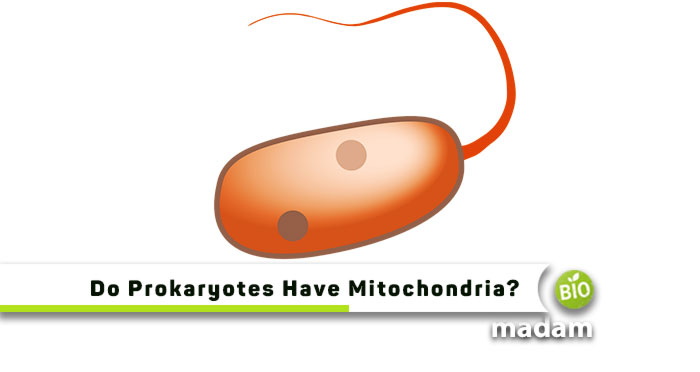All living organisms around us comprise prokaryotic or eukaryotic cells. Prokaryotic cells are quite simple as they do not have many membrane-bound organelles, including a nucleus and a few others. However, they still have the genetic material required for growth and reproduction. One question often arises is, “Are mitochondria found in prokaryotic cells?”
This article covers everything about mitochondria in prokaryotic cells and how they obtain energy.
What are Prokaryotic Cells?
Prokaryotic cells are the simplest type of cells that lack double-membrane organelles and a nucleus; bacteria and archaea comprise prokaryotic cells.
Prokaryotic cells are usually single-celled organisms with a simple structure. They have a plasma membrane and cytoplasm containing the organelles but no membrane-bound structures.
The nuclear material is present in the cytoplasm as chromatin and not as chromosomes. Prokaryotic cells also have plasmids, ribosomes, and other organelles.
What are Mitochondria?
Mitochondria, also known as the powerhouse of the cell, are double-membrane organelles in a cell. They handle the production of energy or ATP to ensure proper cellular functioning.
Mitochondria are typically 0.5 to 10 μm in size. The number of mitochondria may vary from cell to cell; some have none, while others have many.
They comprise a complex structure constituting the matrix and inner and outer membranes. The outer membrane protects the structure of the organelle, while the inner membrane forms a fold called the cristae. They increase the surface area for chemical reactions to produce ATP.
Besides energy production, mitochondria also contribute to cell growth, death regulation, and storing calcium. Furthermore, they help detoxify ammonia in liver cells in the human body.
Do Prokaryotes have Mitochondria?
As mentioned earlier, mitochondria are double-membrane-bound organelles, and prokaryotes do not have any membrane within the cytoplasmic membrane.

So, prokaryotes do not have mitochondria.
The endosymbiotic theory explaining mitochondria formation mentions another cell engulfed mitochondria and never digested. Thus, when the cell multiplied, each daughter cell had mitochondria. Mitochondria were independent organisms themselves that the cell enclosed because of endosymbiosis.
As mitochondria are just the size of prokaryotes, they are absent in these cells.
Energy Production in Prokaryotes without Mitochondria
Now that you have the answer to “Are mitochondria found in prokaryotic cells,” the next thing that comes to mind is, “Then, how do prokaryotes make energy?”
In the absence of mitochondria, prokaryotes obtain their energy from their surroundings. They get most of their energy from the electron transport chain reactions in the plasma membrane.
The energy obtained from the surroundings works fine enough for prokaryotic cells as they do not have extensive cellular functions like eukaryotic cells. They get carbon from their surroundings, which is necessary to survive. Prokaryotes produce energy using their plasma membrane in place of the mitochondrial membrane; the process takes place through aerobic phosphorylation.
The prokaryotes’ ability to absorb nutrients and produce energy increases as they grow. However, they are still smaller than other cells to ensure energy enough for the cell to live.
The Bottom Line
Prokaryotes are simple cells without membrane-bound organelles. They are typically single-celled and lack a membrane-bound nucleus. Students often wonder, “Are mitochondria found in prokaryotic cells?” They are not. Like other membrane-bound organelles, mitochondria are also absent in prokaryotic cells. In the absence of mitochondria, prokaryotes obtain their energy by absorbing carbon from their surroundings and converting it into usable energy in the cell membrane.
FAQs
Why are mitochondria not found in prokaryotic cells?
Prokaryotic cells are simple entities, lacking many membrane-bound organelles. Mitochondria are among such organelles you can see in eukaryotic cells but not prokaryotes.
Is the mitochondria in a prokaryotic plant or animal cell?
Mitochondria are double membrane-bound organelles present in all eukaryotic organisms. As plants and animals both constitute eukaryotic cells, they have mitochondria.
Do all bacteria have mitochondria?
Bacteria and archaea comprise prokaryotic cells, and mitochondria are not present in these cells. Thus, bacteria do not have mitochondria.
What components are found in prokaryotic cells only?
Eukaryotes are complex cells, while prokaryotes are comparatively simple. Prokaryotic cells have a plasma membrane, cytoplasm, dispersed DNA, and ribosomes. Eukaryotic cells also have these organelles.
What are the 3 characteristics of a prokaryotic cell?
Prokaryotic cells are small and simple. They lack double-membrane bound organelles, and the nucleus is dispersed in the cytoplasm.

Anna has completed her degree in Pharmacy from the University of Hawaii. She is serving as a research assistant in a pharmaceutical company. She had a great interest in writing blogs, traveling to different parts of the US, and trying delicious recipes in her spare time.

